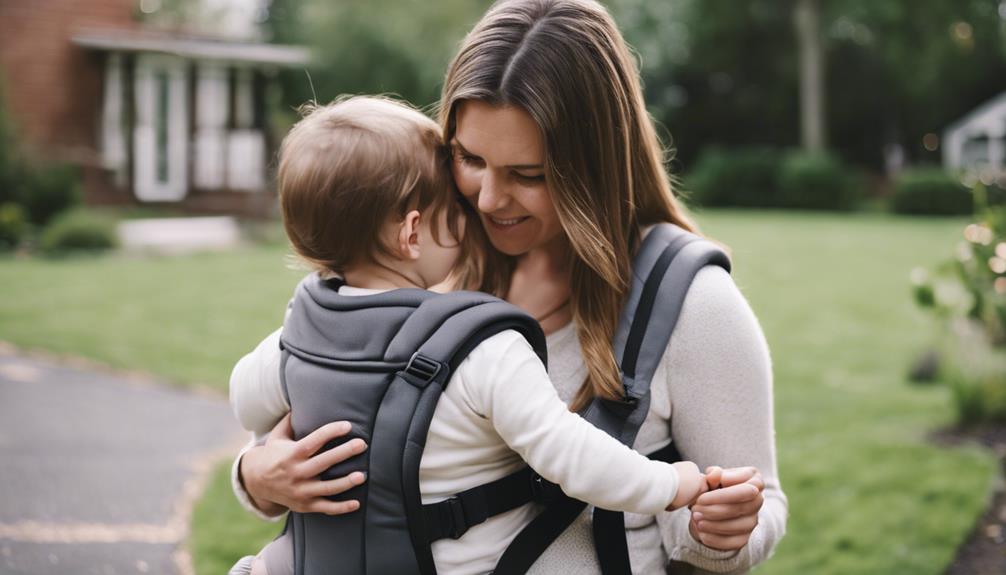To successfully homeschool with a baby, make sure to prioritize schoolwork in the morning, aligning your schedule with your baby’s settled times for optimal productivity. Utilize baby carriers for hands-free mobility and bonding. Get older siblings involved in caregiving duties to promote teamwork and empathy. Create a designated play area for your little one’s safety and engagement. Incorporate sensory activities for cognitive development by exploring different textures and sounds. Keep your baby entertained and learning with safe, age-appropriate toys. Maintain a flexible schedule that revolves around caregiving and educational tasks. Don’t forget that self-care is crucial for your well-being. Aim for a harmonious balance by effectively blending caregiving and schooling.
Key Takeaways
- Utilize baby carriers for hands-free schooling.
- Designate a baby play area for safe exploration.
- Involve older siblings in caregiving responsibilities.
- Prioritize self-care to prevent burnout.
- Incorporate sensory activities for cognitive development.
Strategic Timing for Schoolwork
To guarantee, it's crucial to
During the early morning hours, prioritize schoolwork when your baby is typically more settled and content. This strategic timing allows you to focus on educational tasks while your little one is calm, creating a conducive environment for learning. By planning schoolwork during this time, you can make the most of the quiet moments before the day gets busier.
Utilizing this time effectively can enhance your productivity and help you accomplish more in a shorter period. It's crucial to create a plan that aligns with your baby's schedule to guarantee a harmonious balance between caring for your child and focusing on educational activities. By structuring your day around these strategic timings, you can optimize your homeschooling experience and make the most of each moment.
Remember to be flexible and adjust your schedule as needed to accommodate your baby's needs. By prioritizing schoolwork during these settled times, you can create a productive learning environment for both you and your little one.
Utilizing Baby Carriers or Slings

Consider incorporating baby carriers or slings into your homeschooling routine for hands-free mobility and enhanced bonding with your little one during educational activities. Baby carriers are designed to provide ergonomic support for your baby's posture and comfort while allowing you to move around freely. This can be especially useful when teaching older siblings, as it helps calm a fussy baby and keeps them close to you.
Using a baby carrier or sling not only benefits you practically but also fosters a deeper bond between you and your child during your homeschooling sessions. The closeness and physical contact promote a sense of security and warmth, which can enhance the overall learning experience for both you and your baby.
With a variety of styles and designs available, you can choose a baby carrier that suits your preferences and comfort. Whether you opt for a structured carrier or a wrap-style sling, incorporating this tool into your homeschooling routine can make the experience more manageable and enjoyable for both you and your little one.
Involving Older Siblings in Care

Encourage your older children to take on caregiving responsibilities by involving them in feeding, changing diapers, and playtime with the baby. Assign them age-appropriate tasks such as reading to the baby or helping with soothing techniques to teach teamwork skills and foster empathy.
Sibling Care Responsibilities
To involve older siblings in caring for a baby while homeschooling, assign them age-appropriate roles that match their abilities and strengths. This not only helps in sharing the caregiving responsibilities but also fosters a sense of teamwork and responsibility among siblings.
Consider the following suggestions to involve older siblings in caring for the baby effectively:
- Encourage Participation: Involve older siblings in tasks like diaper changes, feeding, or playing with the baby. This not only lightens the load but also strengthens the bond between siblings.
- Match Strengths: Pair siblings based on their strengths and personalities. For example, a more nurturing sibling can handle soothing the baby, while a more organized one can assist in preparing bottles or organizing baby supplies.
- Promote Teamwork: Create a harmonious caregiving dynamic by emphasizing teamwork. Encourage older siblings to work together, communicate effectively, and support each other in caring for the baby during homeschooling sessions.
Teaching Teamwork Skills
Implementing a buddy system where older siblings actively participate in caring for the baby can effectively teach them responsibility and teamwork skills. Assigning specific tasks to older children not only fosters a sense of ownership and involvement but also encourages them to share their knowledge and skills with the younger ones.
By promoting a supportive learning environment, older siblings can cultivate a culture of collaboration and mutual support through shared responsibilities in caring for the baby. Distributing tasks based on abilities and interests creates a harmonious and efficient caregiving team among siblings.
This approach not only lightens the load for parents but also instills valuable life skills in older siblings, such as time management, problem-solving, and empathy. Through actively engaging in caring for the baby, older siblings learn to work together, communicate effectively, and appreciate the importance of teamwork in a family setting.
Designated Baby Play Area

Establishing a designated baby play area in your homeschooling space is essential for creating a safe environment where your little one can explore and play. By including baby-friendly activities and toys in this space, you can keep your baby engaged while you focus on teaching your older children.
Supervising and engaging with your baby in this designated play area will help maintain a balance in your responsibilities effectively and guarantee a productive homeschooling environment.
Safe Play Space
Design a secure and engaging play area for your baby within the homeschooling space, ensuring it's equipped with interactive toys and safe surroundings. To create a safe play space for your little one, follow these tips:
- Baby-Proofing Measures: Install safety gates, cover electrical outlets, and secure furniture to prevent accidents and injuries.
- Interactive Toys: Include age-appropriate toys that encourage exploration and learning, such as soft blocks, rattles, and colorful mobiles.
- Sensory Items: Incorporate sensory play items like textured balls, musical toys, and soft mats to stimulate your baby's senses and promote cognitive development.
Baby-Friendly Activities
To enhance your baby's learning and engagement while homeschooling, establish a designated play area equipped with age-appropriate toys and activities. This space should be tailored to provide interactive playtime and sensory experiences that stimulate your baby's development. Incorporate soft mats, colorful toys, and items that encourage exploration to keep your little one engaged while you teach older children. Here is a table to give you some ideas for baby-friendly activities in the designated play area:
| Activity | Description | Purpose |
|---|---|---|
| Soft Sensory Balls | Soft, textured balls for tactile play | Enhance sensory development |
| Musical Toys | Toys that play music or sounds | Encourage auditory stimulation |
| Busy Boards | Boards with latches, switches, and doors | Promote fine motor skills |
| Sensory Bottles | Bottles filled with colorful objects | Provide visual and auditory stimulation |
Supervision and Engagement
Establish a dedicated play area within your homeschooling space to guarantee your baby is supervised and engaged safely during learning sessions. This designated play area will provide a secure space for your little one to explore and play while you focus on teaching older children.
To guarantee effective supervision and engagement, consider the following:
- Use Baby-Friendly Toys: Incorporate toys and activities that are age-appropriate and stimulating for your baby. These toys can keep them engaged and entertained while you manage homeschooling tasks.
- Create a Secure Space: Set up boundaries and safety measures to prevent any accidents or interruptions during your homeschooling sessions. Make sure the play area is childproofed and free from any hazards.
- Accessible Supervision: Position the designated play area within your homeschooling space so that you can easily keep an eye on your baby while attending to your older children's educational needs. This arrangement allows you to balance both schooling and childcare effectively.
Incorporating Sensory Activities

Utilize a variety of sensory activities to engage your baby's developing senses and enhance their cognitive skills during homeschooling. Sensory activities play an essential role in infants' cognitive development, fine motor skills, and sensory processing. By exploring different textures, sounds, colors, and objects, babies can learn about their environment, improve focus, and enhance brain development.
Engage your baby in sensory play through activities like sensory bins, water play, and tactile experiences. These hands-on experiences not only offer bonding opportunities but also provide valuable learning moments. Sensory activities promote cognitive growth by stimulating the baby's senses and encouraging exploration.
Through sensory play, infants can refine their fine motor skills, learn cause and effect relationships, and develop sensory processing abilities. These activities help babies make sense of the world around them and support their overall development.
Incorporating sensory activities into your homeschooling routine can enrich your baby's learning experience and foster a deeper connection between you and your little one.
Engaging Toys for Baby

Engage your baby with a variety of stimulating toys that cater to their developing senses and cognitive growth. When selecting toys for your little one, opt for options that are both safe and age-appropriate.
Interactive toys can play an essential role in keeping your baby entertained and engaged throughout the day. Here are some suggestions to help you choose the best toys for your baby:
- Colorful Rattles: Rattles not only stimulate your baby's auditory senses but also help with their hand-eye coordination as they grasp and shake the toy.
- Soft Plush Toys: Soft and cuddly plush toys offer comfort to your baby while also providing tactile stimulation.
- Musical Mobiles and Activity Gyms: These interactive toys can capture your baby's attention and encourage cognitive development through music and movement.
Flexibility in Scheduling

How can you effectively adapt your daily schedule to accommodate the unpredictable needs of a baby? When homeschooling with a newborn, flexibility in scheduling is key. Practical tips include being prepared to adjust your schedule on the fly to cater to the baby's needs. Embrace the unpredictability by being willing to pivot and make changes throughout the day. Understand that disruptions due to a fussy baby or irregular sleep patterns are temporary and part of the journey. Remember, challenging days will pass, and maintaining a flexible approach will help you navigate them smoothly.
To adjust your schedule effectively, consider incorporating homeschooling moments with your baby to teach older children patience and compassion. By blending caregiving responsibilities with educational activities, you can create a balanced routine that accommodates the needs of both your baby and older children. Embracing flexibility in scheduling not only allows you to address the immediate needs of your newborn but also fosters a supportive learning environment for your entire family.
Balancing Care and Schooling

Effectively balancing caregiving duties with schooling tasks is essential when homeschooling with a baby. To achieve this balance, consider the following:
- Utilize Naptime Efficiently:
Plan educational activities during your baby's nap times to maximize productivity without compromising caregiving responsibilities.
- Incorporate the Baby into Homeschooling:
Engage older siblings or family members in caring for the baby while you focus on schooling tasks. This not only fosters a sense of responsibility but also allows you to concentrate on teaching.
- Create a Flexible Schedule:
Design a schedule that accommodates feeding times and the baby's needs. Being adaptable will help you maintain a harmonious balance between caring for your baby and providing a quality homeschooling experience.
Prioritizing Self-Care

Prioritizing self-care is vital for parents who homeschool with a baby to maintain their well-being and prevent burnout. When juggling the demands of homeschooling and caring for a little one, it's easy to overlook your personal needs.
However, taking time to focus on self-care is essential for your overall well-being. Remember, you can't pour from an empty cup. Prioritizing self-care means recognizing when you need a break, nourishing your body with healthy food, and allowing yourself to rest when necessary.
By tending to your own well-being, you'll be better equipped to handle the challenges of homeschooling with a baby. It's important to acknowledge that your personal needs matter and that taking care of yourself isn't selfish—it's necessary.
Ultimately, prioritizing self-care benefits not only you but also your family as a whole. So, make sure to carve out time for yourself amidst the busyness of homeschooling. Your well-being is worth it.
Frequently Asked Questions
How Do You Homeschool When You Have a Baby?
When you homeschool with a baby, adjust your schedule around their routine, utilize naptime wisely, involve them in learning activities, use baby carriers for hands-free schooling, and prioritize flexibility to create a smoother day.
How Do I Start Homeschooling My 1 Year Old?
Ready to start homeschooling your 1-year-old? Create a flexible routine with short, fun learning activities. Use nap times for focused sessions and sensory play. Engage with interactive books, music, and art projects. Build a play area for exploration.
How to Simplify Life With a Baby?
To simplify life with a baby, establish routines, set up designated areas for feeding and play, and use baby gear for entertainment. Focus on hands-on learning for homeschooling. Prioritize self-care and seek support from loved ones for balance.
How Do I Keep My 1 Year Old Busy While Homeschooling?
Keep your 1-year-old busy during homeschooling by rotating engaging toys and activities. Set up a play area with age-appropriate materials, include sensory play and music, and encourage independent exploration while focusing on teaching older children.
What Is the Most Popular Homeschool Method?
The most popular homeschool methods include Classical Education, Charlotte Mason, Montessori, Unschooling, and Eclectic Homeschooling. Each offers unique approaches to education, such as emphasizing grammar, living books, hands-on learning, child-led exploration, or a mix of styles.
Conclusion
To sum up, homeschooling with a baby may seem challenging, but with the right strategies and mindset, it's definitely manageable.
By incorporating practical tips like strategic timing, involving siblings, and prioritizing self-care, you can create a successful learning environment for your children.
Stay tuned for more helpful advice on tackling the unique journey of homeschooling with a baby.









